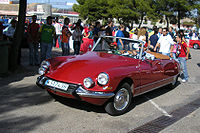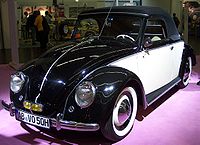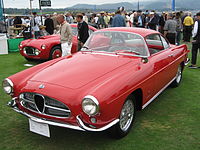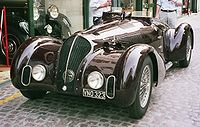- Coachbuilder
-
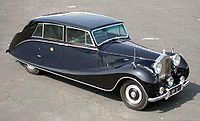 Hooper
Hooper
Rolls-Royce Phantom IV
Touring limousine, 7 seater
for HRH The Prince Regent of Iraq, 1953
this car is 19 ft long and 6 ft 5 inches wideA coachbuilder is a manufacturer of bodies for carriages or automobiles.
The trade dates back several centuries. Rippon was active in the time of Queen Elizabeth I, Barker founded in 1710 by an officer in Queen Anne's Guards, Brewster a relative newcomer (though oldest in the U.S.), formed in 1810.[1] Others in Britain included Hooper, H. J. Mulliner & Co., Park Ward, Gurney Nutting, Freestone & Webb, Barker, Tickford, Thrupp & Maberly, Windover, James Young and Vanden Plas. In France, they were led by Binder, Figoni et Falaschi, Chapron, Kellner, Labourdette, Letourneur et Marchand, Gangloff, Pourtout, Guilloré, Franay or Hibbard & Darrin (formed by Americans). Germany's top firms were Erdmann & Rossi, Gläser, Karmann, Hebmüller, Neuss, and Papler. Italy had firms such as Pininfarina, Bertone, Frua, Castagna, Ghia, Allemano, Scaglietti, Marazzi, Boneschi, Fissore, Alessio (of Turin, responsible for the first eight FIATs built),[2] Zagato, Vignale and Touring. The U.S. featured Brewster & Co., Brunn, Fleetwood, LeBaron, Murphy, Derham, Locke, Rollston and Willoughby.[3] The best known coachbuilder from Holland was Pennock, but there were also Veth & Zn. and Van Rijswijk. In Belgium, it was d'Ieteren and van den Plas and located in Switzerland were Hermann Graber or Ramsauer & Cie which also was known as Worblaufen after the place they were built.
In the early motoring days, when series production did not yet exist, the process of acquiring a new vehicle was more complex. A customer approached a chassis motoring brand, who used to deliver to the customer only the rolling chassis, comprising: chassis, drivetrain (engine, gearbox, differential, axles, wheels), suspension, steering system and the radiator. Noticeable fact is that the radiator was the only visual element identifying the rolling chassis brand. Subsequently the customer approached a coachbuilder, requesting a personal body design to be fitted on the purchased rolling chassis. Initially, the skills used to build the wooden and metal bodies of vehicles were so specialized, (such as the English wheel), that most manufacturers procured contracts with existing coachbuilders to produce bodies for their chassis. For example, Fisher Body built all of Cadillac's closed bodies in the 1910s.
Commonly the larger dealers or distributors of ultra-luxury cars would order for stock chassis and particular bodies thought most likely to sell and have them made in suitable quantities for sale off their showroom floor.
Though automobile manufacturers brought body building skills in-house, the practice of bespoke or custom coachbuilding remained in favour among the rich who continued the habit of centuries past. All ultra-luxury vehicles sold as chassis only. For instance, when Duesenberg introduced their Model J, it was offered as chassis only, for $8,500. Other examples include the Bugatti Type 57, Cadillac V-16, Ferrari 250, Isotta Fraschini Tipo 8 and all Rolls-Royces produced before World War II. Delahaye had no in-house coachworks, so all its chassis were bodied by independents, who created some of their most attractive designs on the Type 135. Most of the Delahayes were bodied by Chapron, Labourdette, Franay, Saoutchik, Figoni & Falaschi, Pennock and many more.
The advent of unibody construction, where the car body is unified with, and structurally integral to the chassis, made custom coachbuilding (in the traditional sense of putting a bespoke body on a factory supplied separate chassis) practically impossible. Many coachbuilders closed down, were bought by manufacturers or changed their core business to other activities:
- transforming into dedicated design / styling houses, subcontracting to automotive brands (e.g. Zagato, Frua, Bertone, Pininfarina).
- and/or transforming into general coachwork series manufacturer, subcontracting to automotive brands (e.g. Karmann, Bertone, Vignale, Pininfarina).
- manufacturing of special coachworks for trucks, delivery vans, touringcars, ambulances, ‘voitures des pompiers’ (fire brigade), public transport vehicles, etc (e.g. Pennock, Veth & Zoon, Akkermans, Heuliez).
- becoming technical partner for development of e.g. roof constructions (e.g. Karmann, Heuliez) or producer of various (aftermarket) automotive parts (e.g. Giannini).
Coachbuilding survived for a time among low-production companies such as Rolls-Royce, Ferrari, Bentley and glassfiber reinforced plastic Corvette because of its low cost for a short run.[4] Producing body dies is extremely expensive (a single door can run to US$40,000), which is only practical when large numbers are involved.
Coachbuilders are: carrossiers in French, carrozzeria in Italian, karosseriebauer in German and carroceros in Spanish.
In reference to a recreational vehicle or motorhome, coach-built means a vehicle which has been purpose-built, using only a chassis as a base vehicle, as opposed to a conversion which is built inside an existing vehicle body.
See also
Notes
External links
Categories:- Coachbuilders
- Car manufacturers
Wikimedia Foundation. 2010.

